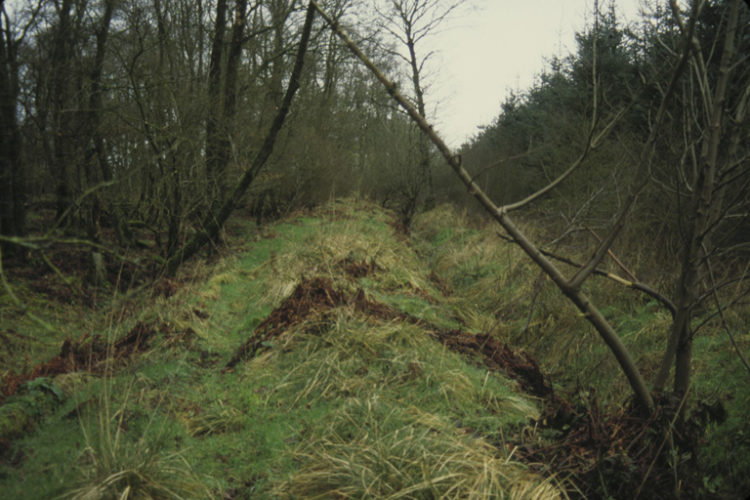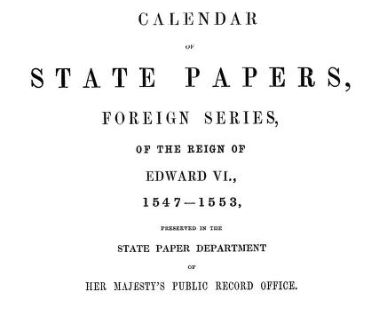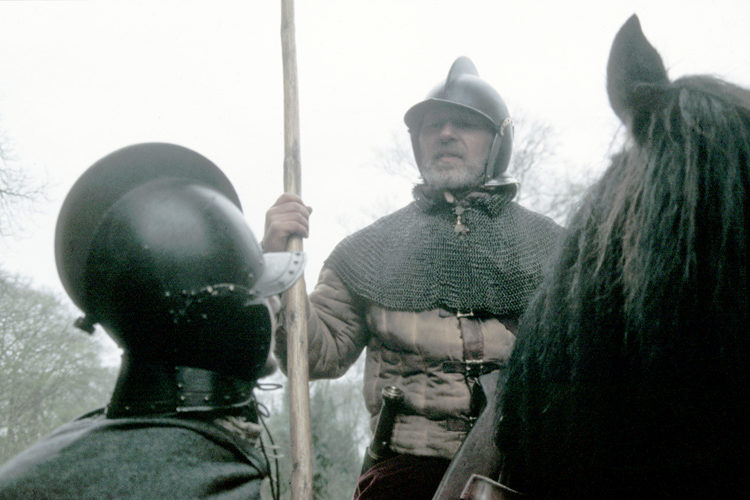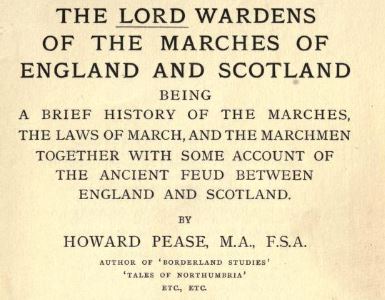“The Scottish navy was powerful enough and enterprising enough to interfere with the commerce of…

Scots Dike, The Debateable Land
Scots’ Dike earthwork marking Scotland / England frontier of 16th century Debateable Land
The double ditch and embankment of the Scots’ Dike are still identifiable in parts, though now little more than a low mound with traces of a ditch on each side. The remains run for four miles through a narrow plantation and terminate in the east near the Scotsdike Hotel and in the west near the River Sark.
The only section of the Anglo-Scottish Border in the west that does not follow a natural feature is marked by the Scots’ Dike. It was built across the Debateable Land to mark the frontier between England and Scotland and at one time the ends were marked by stones bearing the arms of the sovereigns.
In 1552 an Anglo-Scottish commission met to divide the disputed Debateable Land whose unruly inhabitants had been a thorn in the sides of both governments for too long. The French Ambassador acted as arbitrator and the frontier was agreed on. The Scots’ Dike was constructed the following year.
Location: Dumfries and Galloway, Dumfriesshire
OS sheet: 85 NY GR: 362736
THE DEBATABLE LAND ITS EXTENT, CUSTOM, AND FINAL DIVISION
From The Lord Wardens Of The Marches Of England And Scotland by Howard Pease. Limited to 500 copies. Published 1912. Available free online from Cornell University Archives.org. Page references are in the form eg Wp55 = Wardens page 55
Wp55
The very extent of the ‘ Debatable Land ‘ seems to be ‘debatable,’ for various are the dimensions assigned to it ; the measurement most commonly given is that of eight miles long by four broad, and the content of it the land that lay between the rivers of Sark l and Esk stretching from the Sol way up to Kirkandrews, close to Canonby.
Yet Lord Dacre in 1550, two years before the division, reports as Warden of the English Western March that he thought it advisable ‘for the better maintenance of the king’s title and interest of the Debateable Land to go over the same water [of Sark] into the same Rateable, before we either demanded, or granted any assurance/ Now as the meeting was appointed at Lochmabenstone, which is beside Solway in Dumfriesshire, near to Gretna Green, it is clear that Lord Dacre did not limit its extent to the lines of the Esk and Sark rivers. the White Sark ; a small confluent that flows into Sark by Solway Moss is termed the Black Sark.
before the division is thus given by Burn and Nicholson, vol. i. p. 16, from boundaries as set forth in an old roll. ‘ Beginning at the foot of the White Scyrke running into the sea, and so up the said water of Scyrke, till it come to a place called the Pyngil- burne foot running into the said water of Scyrke, and up the Pyngilburne till it come to Pyngilburne know, from thence to the Righeads, from the Righeads to the Monke Rilande Burne, and from thence down Hawenburne till it fall in Eske, and through Eske to the foot of Terras, and so up Terras to the foot of Reygill, and up the R-eygill to the Tophous, and so to the standing stone, and to the Mearburne head and down Mearburne to it fall in Lyddal at the Rutterford, and down Lyddal to it fall in Eske, and down Eske to it fall in the sea.’
They add, ‘ it was in length 8 computed miles of the country and in breadth 4 miles/ but from where the Sark flows into Solway to Raegill [Reygill] is nearly ten miles, and the breadth from Raegill to the Rutterford on Liddel is not far from five miles, and this would seem to be the more correct computation, for after the division between England and Scotland the English portion measuring by Blaeu’s map from west to east from Sark to Esk is some three and three-quarter miles, and in length by the Esk to the Solway is some four and a quarter miles.
In the survey of ‘the Debat cable 1 and Border Lands adjoining the Realm of Scotland/ taken for James i. in 1604, there is ‘an Abreviate of the Survey of the King’s mat 8 lands, called the Debateable lands, in- habited by the Grahams, belonginge to and lyinge within ye Realme of Englande ; the w ch are bounded by ye river of Sark on the west, the Scotishe dike on the North (bothe wch are marches and bounders betwixt ye 2 realms of Englande and Scotland), the ryver of Eske upon the East, and an arme of the sea upon ye South, wch is called Selwaie Sands. The wch ground extendeth in circuit 21 miles, in length 5, and in breadth neere 3 miles, and conteyneth 7 ‘4 03 acres accordinge to Statute measure/
Again, there is printed in Armstrong’s History of Liddesdale a very interesting document in which, by the way, the extent is set down as ten miles by four, entitled, ‘ A Rememberance of an order for the De- batable Lannde, if the sayme shalbe thoght goode, to the Prynce of bothe the reallmys of Inglande and Scotlannde by the Wardans of the weste Marches of Inglannde annde Scotlannde, withe the full advyse and opeanyon of dyvers gentlemen Borderers off bothe the sayde west marches, as the articullys off the same insewethe’ in 1537.
From this we learn that previously to the division the custom had been for both Scots and English to pasture their several cattle thereon ‘for bytt off mouthe betwene son and son/ viz. from sunrise to set, and ‘ withe owtt a stobe or stake, 1 ‘ that is, with- out setting up any residence therein.
But Scots and English alike had come ‘ to hold stob and staik ‘,[ie to have permanent residence there.’ ] therein, and when they who were inclined to England were molested by the Scots Warden the English Warden naturally took upon himself their protection. Thus, when Lord Maxwell threatened to raze Sandie Armstrong’s house with gunpowder, Lord Dacre heaped peats and turfs within and about it and set them on fire to prevent the other’s intention.
This ancient custom in regard to the disputed tract is fully set out by the English Warden, Lord Dacre, in his letter to the Scots Privy Council, 6th July 1517 :-
‘ My Lords there is a grounde called the Debatable grounde, lyeing betwene the realme of England and Scotland, wherein there is no strife for the boundes of the same ; but it is wele knowne by the subjects of bothe the realmes, and allweyes has been used and accustumed to pasture upon the same grounde with bit of mouthe, from the sonne rising to the sonne setting, withal] manner of cattell, for the subjects of bothe the realmes.
‘ And if any subject of ayther realme wilfully will stub or stake, or kepe any cattell under cover of night, it is and always has bene at the likkes of the Wardenis, lieutenants and subjects of ayther realme, fyndering them greved, to brenne, destroye, waiste, take and drive awey all suche goods and cattell as there shalbe founde so wilfully kept under cover of night.
‘And if it fortune any of the subjects of ayther realme soo wilfully keping there goodes and catells under cover of night upon the same Debatable grounde, shall not forfaite there goods taken upon the daylight, as afore said, but it is leyful to brenne the houses and to take the goods and catelles and persons prisoners being within the house upon the daye light.
‘ And if the men and goodes got owt of the houses upon the said Debatable grounde, they are fre, and no forfaite made, but the howses to be brent, and the goods within them to be forfaiete.
‘ And if it fortune any subjects of ayther realme to carie awey any of the said houses, or any wodde, gres, or corne growing upon the said Debatable grounde, lyeing upon wanes, carts, or horse bakks, takin with the cariage upon them, within the Debatable grounde, is forfaiete to that subject that so arrests them. But if so be that the cariage be out of the wane, carte or horsebakks or the seisure be made, then there is no forfaicte done.’
Now as the English Warden insisted upon claiming the land in question as English, and the Scots Warden stoutly resisted the claim, a deadlock ensued. ‘ For neither will I,’ wrote Lord Dacre in 1550 to the Privy Council, ‘suffer the Warden of Scotland to answer for it, because I will not allow it to be Scotland, nor will they on the contrary consent that it shall be England.’ Finally, when several ‘ Batablers,’ such as Sandie Armstrong, and several of the brethren and sons of Richard Greyme, and divers others, had threatened to turn Scots unless England would definitely ‘ aid them as occasion required ‘ ‘ a loss to England and a continual source of disorder on the marches ‘ a division of the ‘ variable ground ‘ was finally agreed to.
The following is the reference to this disputed ground in the Leges Marchiarum, three years before the division.
By the indenture of 1549 in the reign of Edward vi. ‘it was covenanted, concorded and con- cluded, that the land variable, common of both the People, called the Debateable ground, which lieth between the west marches of England and Scotland, shall be put and set in the same estate, and shall remain (inasmuch as belongeth to the use thereof), even as it hath been accustomed to be, and was before the beginning of the wars. Wp61
‘ So as the Lieges and Subjects of both the Realms, now inhabiting or having houses upon the said Debateable ground, may have power and liberty (until the Feast of St. Michael the Archangel next coming, after the date hereof) to dwell there, without Prejudice of this Article, and to use and enjoy the same, during such space of time they may to their best Commodity remove themselves, their wives and Children, goods and Cattel, and other their things (every of them) into his own country ; unless it be otherwise in the mean time, of the said Variable Ground, by good ways and means agreed and concluded between the Priners aforesaid. And, after the said Feast, if any of either country of the said , Inhabitants do in anything contrary to this Article, then (by the Warden or his Deputy, without respect), they shall be thrown out and duly punished therefore, according to the Laws of Marche.
‘Provided, that whosoever refuseth to obey the Commandments of the Wardens of both Marches aforesaid, and the Covenants taken by common consent for the good rule thereof, that they occupy not the Privileges of the small delay aforesaid.[Leges Marchiarum]
Finally, then, it was agreed upon between the two realms that there should be a division of the variable ground between England and Scotland by the Lord Wharton and Sir Thomas Challoner on the part of the King of England, and Sir James Douglas of Drumlangrig and Richard Maitland of Lethington on the part of the Queen of Scotland.
These Commissioners, assisted by an envoy from France, ‘made their award Sept. 24th, 1552, setting forth, that whereas the inhabitants of the western part inclined more to be subjects of England, and the inhabitants of the eastern part inclined more to be subjects of Scotland, they therefore award the western part of the said debateable land to the King of England, and the eastern part thereof to the Queen of Scotland ; to be divided by a line drawn across from Esk to Sark and a square stone set up at each end with the arms of England on the west thereof, and the arms of Scotland on the east side.’ 1
And thus the ‘ terra contentiosa ‘ of old time ‘ the sewer of abandoned men who, freed from the fear of punishment or laws, lived by theft and spoil ‘ was divided for all time between England and Scotland England obtaining the western portion or parish of Kirkandrews and Scotland the eastern or parish of Canonby.
North cuntre to prove yt to be Englishe and not Scottishe,’ in 1531 the prior is said to pay ‘ to the handes of the Captain of the Castell of Carlill ‘ xiiis. ivd. This, the English insisted, was rent, but the Scots replied that it was ‘ for custome of the inhabitants within Cannonby.’ See Armstrong, Liddcsdalc, p. xxxii.
It might be mentioned in this connection that there were along the Border certain small ‘threap lands/ ‘ debateable,’ or disputed tracts, which seem to have remained doubtful even up to the time of the Ordnance Survey. Thus from Phillips’s memorandum quoted above, we learn that there were in the East March ‘three parcels’ of ground in dispute, as, for example, ‘ the mid rigg [of 100 acres] lying nere to the cornefeldes of Warke and Carram quietlie occupied and plowed by the tenantes of Carram till Flodden Feld, at what time the decay of the Castle of Warke caused the decaye of the towns of Carram and Warke, so as it lay unplowed but occupied as pasture by the tenantes of the said townes till anno 30 of Henry vm. that they did sow it with otes, which the Wardens of the East and Middle marches of Scotland by theyr Kinges commandment, as the Scots affirme, with a great power destroyed, challeng- ing the same ground to be in plea between the realmes and therefore to be pastured uppon by both, as it hath continued ever since.’
Wp62
And again, there seems also to have been a debatable ‘ Fish garth ‘ on the Esk, which is specially mentioned in sundry treaties of Henry vii. and vm. , and set on one side or exempted as a source of quarrel between England and Scotland.



